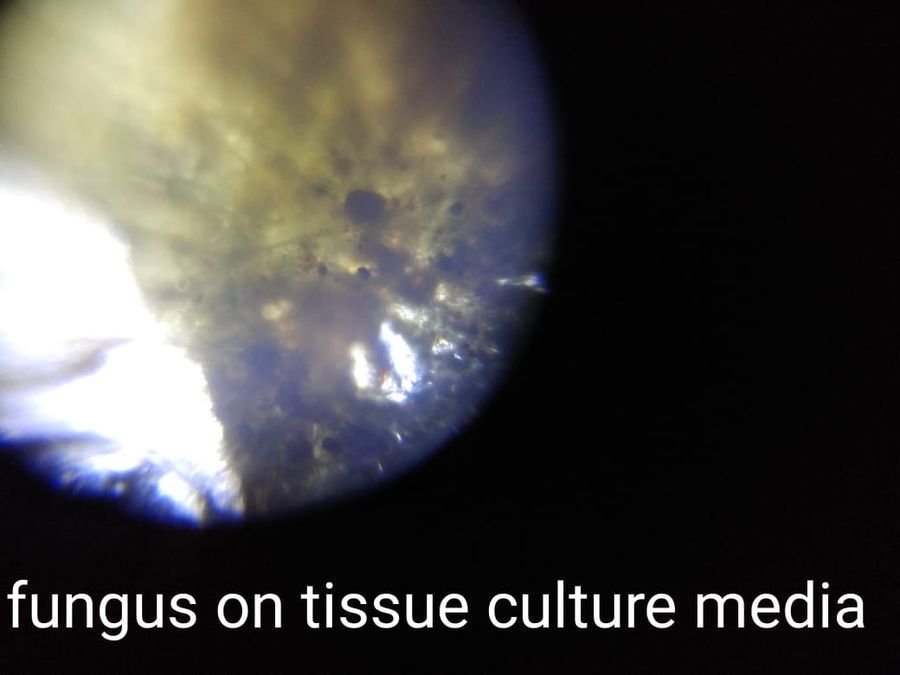Fungal growth on tissue culture medium
 Jun 23, 2019 • 1:57 AM UTC
Jun 23, 2019 • 1:57 AM UTC Unknown Location
Unknown Location 140x Magnification
140x Magnification Microorganisms
Microorganisms
Gopika
Learn about the author...
2posts
0comments
1locations

College : CMR National PU College, ITPL, Bengaluru
Sample: Fungus
Site of sample collection: University of Agricultural Sciences, Bangalore
Date of Collection: 18 June 2019
Date of Observation: 21 June 2019
Students involved: Ramya Nambiar, Shwetha Santhosh, Gopika Anil, Malavika Rajesh
On our trip to the University of Agricultural Sciences, we had collected a sample of fungus growing on a tissue culture medium. The sample was viewed under the foldscope to produce clear and sharp outcomes.
Tissue culture is a method of biological research in which fragments of tissue from an animal or plant are transferred to an artificial environment in which they can continue to survive and function. Plant tissue culture now has direct commercial applications as well as value in basic research into cell biology, genetics and biochemistry.
Fungi or molds produce thin filamentous mycelia and sometimes denser clumps of spores. They are easy to observe under a low power microscope and can even be seen without magnification in advanced stages of contamination. They can appear in a shade of white,yellow or black in culture and when in advanced mycelial growth stages look like large fuzzy patches in the dish or flask. They grow as multicellular filaments called hyphae. A connected network of these multicellular filaments contain genetically identical nuclei, and are referred to as a colony or mycelium.
Sample: Fungus
Site of sample collection: University of Agricultural Sciences, Bangalore
Date of Collection: 18 June 2019
Date of Observation: 21 June 2019
Students involved: Ramya Nambiar, Shwetha Santhosh, Gopika Anil, Malavika Rajesh
On our trip to the University of Agricultural Sciences, we had collected a sample of fungus growing on a tissue culture medium. The sample was viewed under the foldscope to produce clear and sharp outcomes.
Tissue culture is a method of biological research in which fragments of tissue from an animal or plant are transferred to an artificial environment in which they can continue to survive and function. Plant tissue culture now has direct commercial applications as well as value in basic research into cell biology, genetics and biochemistry.
Fungi or molds produce thin filamentous mycelia and sometimes denser clumps of spores. They are easy to observe under a low power microscope and can even be seen without magnification in advanced stages of contamination. They can appear in a shade of white,yellow or black in culture and when in advanced mycelial growth stages look like large fuzzy patches in the dish or flask. They grow as multicellular filaments called hyphae. A connected network of these multicellular filaments contain genetically identical nuclei, and are referred to as a colony or mycelium.

fungal mass under foldscope
Under the foldscope, the fungal mass appeared in a shade of brown when viewed under the light. The mycelia usually appear as thin, wisp-like filaments, and at some places as denser clumps of spores. The exogenous spores are seen on the sporaniophore.
Cell cultures can often be cured of fungus contamination when detected early by treatment with certain antibiotics (like antimycotics).The two most common antimycotic agents used in cell culture that are effective against fungi or moulds are Amphotericin B (Fungizone) and mycostatin (Nystatin).
Under the foldscope, the fungal mass appeared in a shade of brown when viewed under the light. The mycelia usually appear as thin, wisp-like filaments, and at some places as denser clumps of spores. The exogenous spores are seen on the sporaniophore.
Cell cultures can often be cured of fungus contamination when detected early by treatment with certain antibiotics (like antimycotics).The two most common antimycotic agents used in cell culture that are effective against fungi or moulds are Amphotericin B (Fungizone) and mycostatin (Nystatin).
Sign in to commentNobody has commented yet... Share your thoughts with the author and start the discussion!

 0 Applause
0 Applause 0 Comments
0 Comments